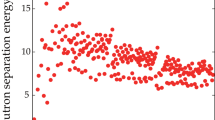Abstract
The ambient equivalent dose and effective dose are calculated using the ROBOT-Monte Carlo code. The absence of conservativity in the ICRU operational quantities with respect to the effective dose is discussed. It is shown that the factors WR need to be revised. 4 figures, 14 references.
Similar content being viewed by others
References
Conversion Coefficients for Use in Radiological Protection Against External Radiation, ICRP Publication 74, Pergamon Press, Oxford (1996).
Radiation Safety. ICRP Recommendations (1990), MCRP Publication No. 60, part 1, and No. 61. ICRP Publication 60, part 2 [Russian translation, Énergoatomizdat, Moscow (1994)].
G. Leuthold, V. Mares, and H. Schraube, “Calculation of the neutron ambient dose equivalent on the basis of the ICR-P revised quality factors”,Rad. Prot. Dosim.,40, No. 2, 77–84 (1992).
H. Schuhmacher and B. Siebert, “Quality factors and ambient dose equivalent for neutrons, based on the new ICRP recommendations”,Rad. Prot. Dosim.,40, No. 2, 85–89 (1992).
R. Hollnagel, “Calculated effective doses in anthropoid phantoms for broad neutron beams with energies from thermal to 19 MeV”,Rad. Prot. Dosim.,44, No. 1/4, 155–158 (1992).
B. Siebert and G. Alberts, “The impact of recent ICRU and ICRP publications on radiation protection against neutrons”, in:Proceedings of the International Conference on Radiation Shielding, Arlington, USA (1994), pp. 25–32.
H. Shuhmacher and B. Siebert, “Quality factors, ambient and personal dose equivalent for neutrons, based on the new ICRU stopping power data for protons and α particles”,Rad. Prot. Dosim.,58, No. 3, 177–183 (1995).
G. Leuthold, V. Mares, and H. Schraube, “On the conservativity ofH p (10)”,Rad. Prot. Dosim.,70, No. 1-4, 379–382 (1997).
R. Hollnagel, “Calculation of the personal dose equivalentH p (10) for neutrons in the MIRD phantom”,Rad. Prot. Dosim.,70, No. 1-4, 387–390 (1997).
S. O. Vyaz'min, E. V. Klass, S. F. Manakov, et al., “State and possibility of the ROBOT program system for calculation of three-dimensional shielding by the Monte Carlo method”, in:Abstracts of Reports at the Sixth Russian Scientific Conference on Protection from Ionizing Radiations from Nuclear-Power Installations, Obninsk, September 20–23, 1994, pp. 106–108.
W. Snyder H. Fisher, Jr., Mary R. Ford, and G. Warmer, “MIRD. Pamphlet 5, Medical Internal Radiation Committee”,J. Nucl. Med., Suppl. 3, 7–12 46–52 (1969).
M. Yu. Vyrskii, A. A. Dubinin, A. I. Ilyushkin, et al., “49-ground constants system for calculating neutron transfer in radiation shielding”, in:Abstracts of Reports at the 3rd All-Union Scientific Conference on Protection from Ionizing Radiations from Nuclear-Power Installations, Tbilisi, October 27–29, 1981, p. 53.
Stopping Powers and Ranges for Protons and Alpha Particles, ICRU Report 49, Bethesda, Maryland (1993).
G. Leuthold and H. Schraube, “Critical analysis of the ICRP 60 proposals for neutron radiation and a possible solution”,Rad. Prot. Dosim.,54, No. 3/4, 217–220 (1994).
Additional information
Central Physicotechnical Institute of the Ministry of Defense of the Russian Federation. Translated from Atomnaya Énergiya, Vol. 87, No. 4, pp. 297–302, October, 1999.
Rights and permissions
About this article
Cite this article
Klass, E.V., Rezontov, V.A. & Shakhovskii, V.V. Questions concerning the determination of the effective external neutron irradiation dose. At Energy 87, 758–762 (1999). https://doi.org/10.1007/BF02673266
Received:
Issue Date:
DOI: https://doi.org/10.1007/BF02673266




